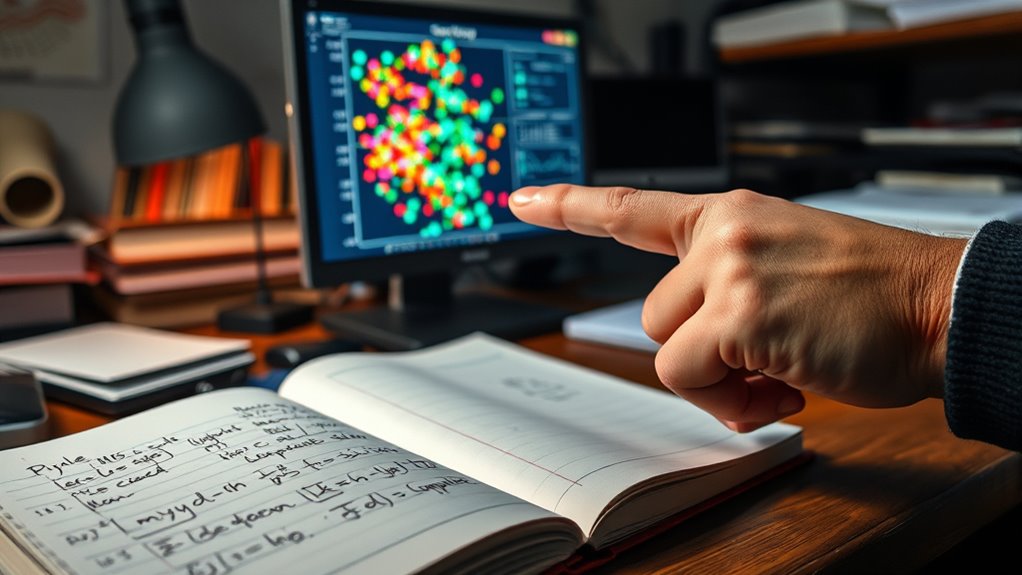To understand experimental data in psychology, you need to grasp how statistical methods help analyze relationships and determine causality. Correlation analysis shows whether two variables are connected, but it doesn’t verify one causes the other. Proper experimental design controls for external factors and allows you to test hypotheses accurately. Mastering these tools ensures your research is valid and reliable. Continuing will reveal how to apply these methods effectively for meaningful findings.
Key Takeaways
- Correlation analysis reveals relationships between variables but does not establish causation in psychological data.
- Experimental design systematically manipulates variables to test hypotheses and determine causal effects.
- Random assignment minimizes bias and controls for extraneous factors, enhancing the validity of psychological experiments.
- Understanding statistical significance helps interpret whether findings are meaningful or due to chance.
- Combining correlation and experimental methods ensures reliable, valid insights into human behavior and mental processes.

Have you ever wondered how psychologists determine whether their findings are meaningful? The answer often lies in understanding the methods they use to analyze data, particularly correlation analysis and experimental design. These tools help you distinguish between random chance and genuine relationships, guaranteeing that the conclusions drawn are valid and reliable. When you look at research results, it’s essential to know whether the observed effects truly reflect what’s happening in the real world or are just statistical flukes. That’s where correlation analysis plays a key role—it examines the relationship between two variables, indicating whether they tend to increase or decrease together. For example, if you find a positive correlation between stress levels and sleep disturbances, it suggests that as stress increases, sleep quality may decline. However, correlation doesn’t imply causation, so you need a carefully planned experimental design to dig deeper.
Experimental design is the backbone of solid psychological research. It involves planning how you manipulate and measure variables to test hypotheses effectively. With a good design, you can control extraneous factors that might influence your results, making your findings more trustworthy. For instance, if you’re studying the effect of a new therapy on anxiety, you’d randomly assign participants to either an experimental group receiving the therapy or a control group receiving a placebo. This randomization reduces bias and helps guarantee that differences in outcomes are due to the intervention itself, not other factors. You also decide on the type of experimental design—whether it’s a between-subjects or within-subjects design—to best suit your research question. Proper experimental design allows you to establish causality, which correlation analysis alone cannot do.
Together, correlation analysis and experimental design form a powerful toolkit for interpreting data. Correlation analysis helps you identify relationships, but without a rigorous experimental design, you can’t confidently say one variable causes changes in another. When you set up experiments carefully, you can test hypotheses with greater precision and draw conclusions that stand up to scrutiny. This combination guarantees that your research isn’t just about observing patterns but about understanding the underlying mechanisms at work. In psychology, where human behavior is complex and multifaceted, employing these methods correctly is essential for producing meaningful, actionable insights. By mastering correlation analysis and experimental design, you’re better equipped to contribute to scientific knowledge and make informed decisions based on robust data. Additionally, understanding the importance of projector technology can greatly enhance your home entertainment setup, ensuring you choose the right equipment for your needs.
Frequently Asked Questions
How Do I Interpret P-Values in Psychological Research?
When interpreting p-values in psychological research, you should see them as indicating the probability of obtaining your results if the null hypothesis is true. Keep in mind the interpretation nuances, like understanding that a p-value below the significance threshold (often 0.05) suggests your findings are statistically significant. However, don’t overstate this; a small p-value doesn’t prove causation, just that the results are unlikely under the null hypothesis.
What Are Common Pitfalls in Collecting Experimental Data?
Did you know that over 60% of studies face issues like sample bias? When collecting experimental data, you might overlook sample bias or accidentally introduce data contamination, skewing results. These pitfalls happen if you don’t carefully select participants or mishandle data collection procedures. To avoid this, guarantee your sample truly represents your population and maintain strict data protocols. This way, your findings stay valid and reliable.
How Can I Improve the Reliability of My Study Results?
To improve your study’s reliability, focus on enhancing measurement validity by using well-validated instruments and standardized procedures. Minimize participant bias through double-blind designs and clear instructions, ensuring participants’ responses aren’t influenced by expectations. Consistently applying these strategies helps produce more accurate, dependable results, strengthening your study’s overall credibility. Regularly reviewing your methods and addressing potential biases will further boost the reliability of your findings.
What Software Is Best for Analyzing Psychological Data?
Think of software as your toolkit for exploring psychological data. For analyzing data, SPSS and R are top contenders; SPSS offers user-friendly interfaces and robust data visualization, while R provides extensive flexibility through packages for detailed analysis. Compare their features to find what fits your needs best. Both tools help you uncover patterns, but choose based on ease of use versus customization to make your data truly speak.
How Do I Handle Missing Data in Experiments?
To handle missing data in experiments, start with data validation to identify gaps. Then, use imputation techniques like mean substitution, regression imputation, or multiple imputation to fill in missing values accurately. These methods help maintain data integrity and reduce bias. Always assess how the imputation influences your results, and consider sensitivity analyses to ensure your findings remain robust despite the missing data.
Conclusion
Now that you’ve mastered these statistics, you’re practically a superhero of psychology research! Imagine wielding the power to decode every experiment’s secrets, uncover hidden truths, and make groundbreaking discoveries. With these skills, you could revolutionize the way psychology understands the mind—no challenge is too big! So go ahead, conquer those data sets, and turn yourself into the ultimate detective of the human psyche. The world of psychology is waiting for your genius!










